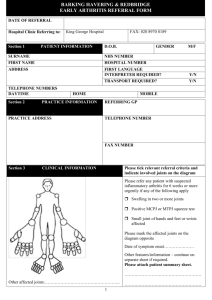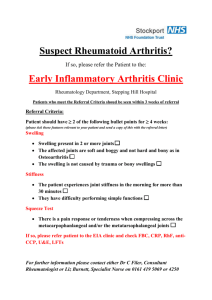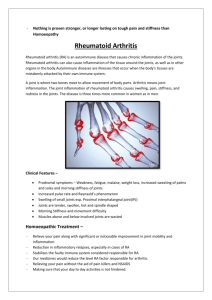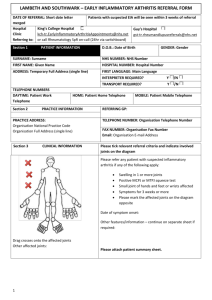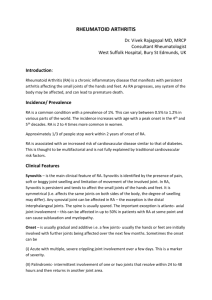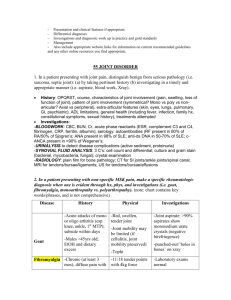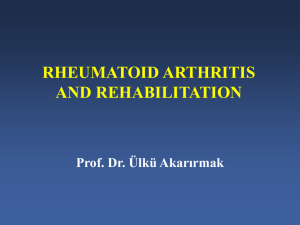rheumatology history
advertisement
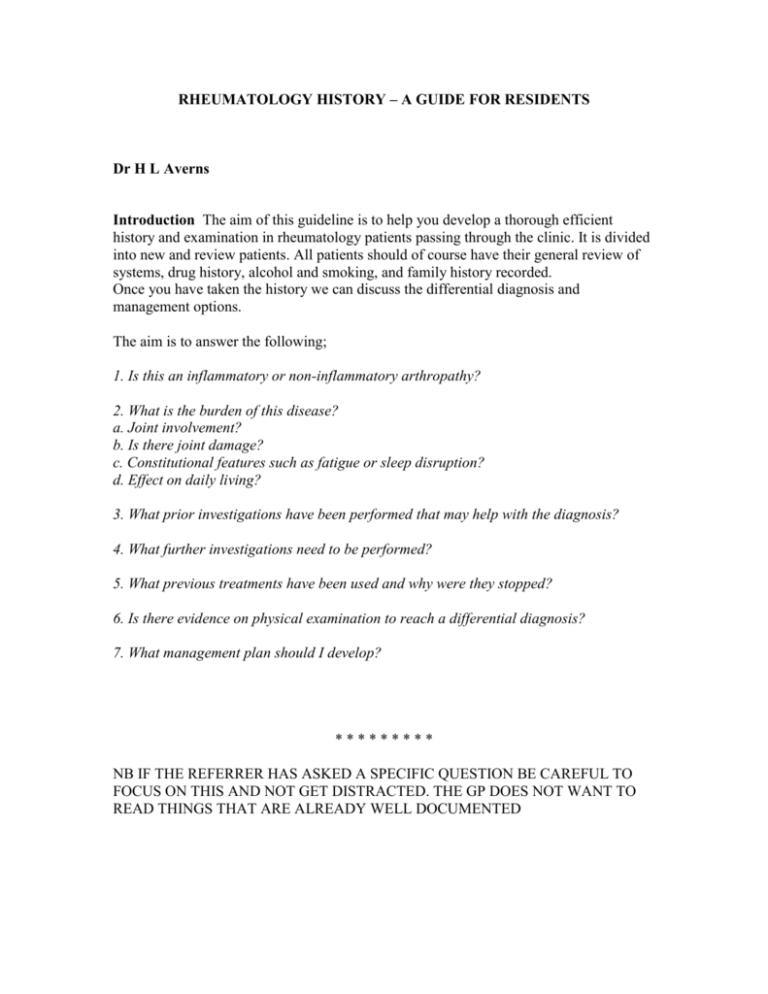
RHEUMATOLOGY HISTORY – A GUIDE FOR RESIDENTS Dr H L Averns Introduction The aim of this guideline is to help you develop a thorough efficient history and examination in rheumatology patients passing through the clinic. It is divided into new and review patients. All patients should of course have their general review of systems, drug history, alcohol and smoking, and family history recorded. Once you have taken the history we can discuss the differential diagnosis and management options. The aim is to answer the following; 1. Is this an inflammatory or non-inflammatory arthropathy? 2. What is the burden of this disease? a. Joint involvement? b. Is there joint damage? c. Constitutional features such as fatigue or sleep disruption? d. Effect on daily living? 3. What prior investigations have been performed that may help with the diagnosis? 4. What further investigations need to be performed? 5. What previous treatments have been used and why were they stopped? 6. Is there evidence on physical examination to reach a differential diagnosis? 7. What management plan should I develop? ********* NB IF THE REFERRER HAS ASKED A SPECIFIC QUESTION BE CAREFUL TO FOCUS ON THIS AND NOT GET DISTRACTED. THE GP DOES NOT WANT TO READ THINGS THAT ARE ALREADY WELL DOCUMENTED New Patients; History The following is the minimum dataset that should be collected for new referrals with arthritis. Demographic data – different arthropathies occur at different stages of life Disease course: When did you first notice a problem? Is this an acute process where we might prevent future damage, or a long standing problem where intervention may do little to improve the outcome? How did it start? Overnight presentation; uncommonly RA, often reactive arthritis, acute gout Over days / weeks; inflammatory polyarthritis Insidiously over months; degenerative arthritis Is there a pattern to the joint pain Does it come and go? Unlikely in OA Are new joints being recruited (additive pattern); common in RA Eg OA will not generally affect wrists and MCPs if primary. Have you seen swelling? Be very specific. Which joints? Are they warm, do they go red? NB RA patients do not get red joints as a rule. Consider gout, or maybe psoriatic arthritis. A single red joint might be sepsis. Is it a general feeling of swelling or particular joints? Are you worse at any particular time of day? Ask about length of early morning stiffness (in minutes). > 60 may be significant and point to an inflammatory arthropathy. Are they better with exercise? Patients with RA and AS often dread sitting down to rest as they stiffen up. Patients with OA tend to be worse the more they use the joint. Do you feel unwell / tired? Patients with inflammatory arthritis often feel a general malaise. Fibromyalgia patients often report feeling ill (if I go shopping I am wiped out for the next 3 days). OA patients may be a bit tired but not really unwell Have you had fevers or weight loss? True fevers may indicate SLE / CT disease, or infection. They will not occur in OA Ill patients with RA may lose weight. How has the arthritis affected you ability to do things… I tend to imagine a normal day ie can you get out of bed, get to the bathroom, wash, dress, eat etc. This way you will find you get a good history of daily function. Are they able to work? Has this affected their sex life? NB PLEASE ask the patient to complete a HAQ if there is significant functional loss. If you suspect ; Seronegative spondyloarthritis - ask about psoriasis, new sexual contacts, dysuria, iritis, bowel problems. Consider enthesopathies and dactylitis. Post infectious eg parvovirus – ask about history of precipitating infections CT disease – ask about rashes, Raynauds, pleuritic pain, sicca symptoms, thromboses, miscarriages What is your current medication? Consider GI and other risks of NSAIDs Consider future plans for pregnancies which would contraindicate most DMARDs Consider contraindications to some drugs eg latent TB, hx of MS Have you ever tried…methotrexate, sulfasalazine, hydroxychloroquine, penicillamine, gold. azathioprine, leflunomide Many patients will have tried previous DMARDs. How long did they take them? Did they take them at a high enough dose or for long enough? Why were they stopped? Toxicity, inefficacy or not clear? Are they aware of the side-effects and monitoring requirements of their medication? Examination Record on the homunculus the number and distribution of swollen and tender joints. Differentiate bony from soft tissue swelling. Be specific about synovitis and if unsure ask. Record extra-articular features in particular nodules, eye problems, skin involvement. Always examine the heart, lungs, and abdomen thoroughly in new patients PLEASE make sure all new patients have completed a HAQ, and have scored their pain and global disease activity out of 100. This is essential for calculating the EULAR DAS score. Review of patients with RA The aim of the review appointment is to ensure that the disease is under optimal control, ie. that we are doing the best to improve the long term outcome. YOU DO NOT NEED TO TAKE A BRAND NEW HISTORY!! In patients with long standing disease it is sometimes hard to work out where to start, so the following is a guide to help you. N.B. All of my patients with inflammatory arthritis should complete a HAQ. Ask about pain and global well-being out of 100 and record this clearly . Get a recent (within 1-2 weeks ESR) or check it from clinic. What joints are particularly bothering you today? You may find that there is one specific joint which might for example benefit from injection. You may feel that the time has come to consider orthopedic referral. How long are you stiff for in the morning (minutes)? How well controlled do YOU feel the arthritis is? Patients are very good at indicating to you if they are doing OK, or going through a selflimiting flare. You will get an idea about how well-educated the patient is about the illness. Do you have any problems with your eyes? Sicca symptoms, episcleritis What drugs are you taking? Are you being monitored? WHO is looking at the results and do you KNOW that they are satisfactory? You must record that monitoring is safe and satisfactory. If on NSAIDs are they working? Consider the risk vs benefits. If on steroids are they working. Consider long term toxicity eg osteoporosis. Take a brief functional history (i.e. take them through a typical day). Are they getting worse? EXAMINATION NB Record on the homunculus the number and distribution of swollen and tender joints. Be specific about synovitis and if unsure ask. Are there new nodules? Check results of investigations CRP / ESR may show disease activity. CBC, LFT will show toxicity to DMARDs. Patients with very active disease are often anaemic. Synthesising your opinion and plan If length of EMS is stable, function is stable, and there is not much active synovitis you may be happy with the current level of disease control. However if there is a large number of active joints, pronounced EMS, pain, malaise, functional deterioration and a significantly raised CRP you may think about changing the DMARD either by increasing the dose, adding another, or completely changing it. Occasionally a one-off depomedrol injection is worth considering to get through a flare. Do you need to inject a joint? If time is short please arrange a return to the injection slots on a Friday. Do you need to change the NSAID? Always consider referral to OT, physiotherapy and podiatry.
